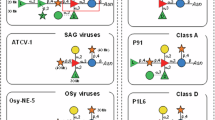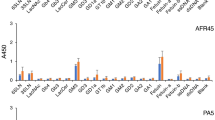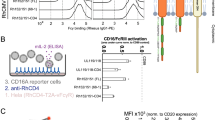Abstract
MAMMALIAN C-type retroviruses are inactivated by human serum1,2, following triggering of the classical complement cascade3. This may have inhibited transmission to humans of C-type oncoviruses from other mammals1. Indeed, the retro-viruses human immunodeficiency virus and human T-cell leukaemia virus are resistant to human complement4,5. Antibody-independent activation of human Clq, the first component of the classical pathway, by retroviral envelope proteins has been described6. However, retroviruses produced from human cells are resistant to inactivation by human complement7,8 and human serum is known to contain antibodies directed against carbohydrates on retroviral envelopes9–11. Gal(αl–3)Gal terminal carbohydrates are expressed by most mammals but are absent in humans, which lack a functional (αl–3)galactosyltransferase gene12,13.Here, we demonstrate that anti-Gal(αl–3)Gal antibodies in human serum inactivate retroviruses produced from animal cells. Expression of porcine (αl–3)galactosyltransferase14–16in human cells renders the cells and the retroviruses they produce sensitive to human serum.
This is a preview of subscription content, access via your institution
Access options
Subscribe to this journal
Receive 51 print issues and online access
$199.00 per year
only $3.90 per issue
Buy this article
- Purchase on SpringerLink
- Instant access to full article PDF
Prices may be subject to local taxes which are calculated during checkout
Similar content being viewed by others
References
Welsh, R. M., Cooper, N. R., Jensen, F. C. & Oldstone, M. B. A. Nature 257, 612–614 (1975).
Welsh, R. M., Jensen, F. C., Cooper, N. R. & Oldstone, M. B. A. Virology 74, 432–440 (1976).
Cooper, N. R., Jensen, F. C., Welsh, R. M. & Oldstone, M. B. A. J. exp. Med. 144, 970–984 (1976).
Banapour, B., Sernatinger, J. & Levy, J. A. Virology 152, 268–271 (1986).
Hoshino, H., Tanaka, H., Miwa, M. & Okada, H. Nature 310, 324–325 (1984).
Bartholomew, R. M., Esser, A. F. & Muller-Eberhard, H. J. J. exp. Med. 147, 844–853 (1978).
Takeuchi, Y. et al. J. Virol. 68, 8001–8007 (1994).
Cosset, F. L., Takeuchi, Y., Battini, J. L., Weiss, R. A. & Collins, M. K. L. J. Virol. (in the press).
Barbacid, M., Bolognesi, D. & Aaronson, S. A. Proc. natn. Acad. Sci. U.S.A. 77, 1617–1621 (1979).
Snyder, H. W. Jr & Fleissner, E. Proc. natn. Acad. Sci. U.S.A. 77, 1622–1626 (1980).
Löwer, J., et al. Virology 109, 409–417 (1981).
Larsen, R. D. Rivera-Marrero, C. A., Ernst, L. K., Cummings, R. D. & Lowe, J. B. J. biol. Chem. 265, 7055–7061 (1990).
Galili, U. & Swanson, K. Proc. natn. Acad. Sci. U.S.A. 88, 7401–7404 (1991).
Gustafsson, K., Strahan, K. & Preece, A. Immun. Rev. 141, 59–70 (1994).
Strahan, K. M. et al. Immunogenetics 41, 101–105 (1995).
Sandrin, M. S. & McKenzie, I. F. Immun. Rev. 141, 169–190 (1994).
Hamadeh, R. M. et al. J. clin. Invest. 89, 1223–1235 (1992).
Galili, U., Mandrell, R. E., Hamadeh, R. M., Shohet, S. B. & Griffiss, J. M. Infect. Immun. 56, 1730–1737 (1988).
Galili, U., Anaraki, F., Thall, A., Hill-Black, C. & Radic, M. Blood 82, 2485–2493 (1993).
Almeida, I. C., Krautz, G. M., Krettli, A. U. & Travassos, L. R. J. clin. Lab. Anal. 7, 307–316 (1993).
Oriol, R., Ye, Y., Koren, E. & Cooper, D. K. Transplantation 56, 1433–1442 (1993).
Sandrin, M. S., Vaughan, H. A., Dabkowski, P. L. & McKenzie, I. F. Proc. natn. Acad. Sci. U.S.A. 90, 11391–11395 (1993).
Repik, P. M., Strizki, J. M. & Galili, U. J. gen. Virol. 75, 1177–1181 (1994).
Welsh, R. M. J. Immun. 118, 348–354 (1977).
Hirsch, R. L., Griffin, D. E. & Winkelstein, J. A. J. Immun. 127, 1740–1743 (1981).
Fabre, J. W. Nature Med. 1, 403–404 (1995).
McCurry, K. R. et al. Nature Med. 1, 423–427 (1995).
Cosset, F. L. et al. J. Virol. 69, 6314–6322 (1995).
McKenzie, I. F. C. et al. Lancet ii, 386–387 (1968).
Battini, J. L., Heard, J. M. & Danos, O. J. Virol. 66, 1468–1475 (1992).
Author information
Authors and Affiliations
Rights and permissions
About this article
Cite this article
Takeuchi, Y., Porter, C., Strahan, K. et al. Sensitization of cells and retroviruses to human serum by (αl-3) galactosyltransferase. Nature 379, 85–88 (1996). https://doi.org/10.1038/379085a0
Received:
Accepted:
Issue Date:
DOI: https://doi.org/10.1038/379085a0



